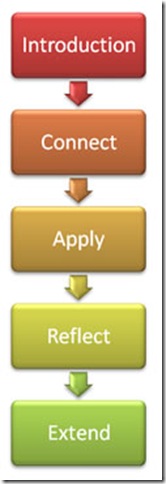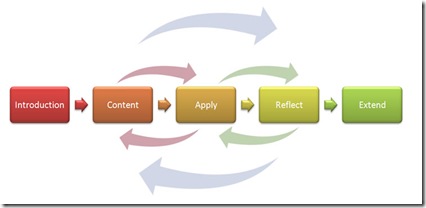We have now reached the “precipice of the crossroads” as Sopranos’ character Little Carmine said. 
So far, all the models I've talked about in this E-Learning Curve Blog series have described a linear process in the design of learning events, for the purpose of delivering the content in a classroom environment.
This approach has been variously categorized as "phased," "stepped," and "unit-based." It assumes a pretty sophisticated knowledge of pedagogy, as well as a degree of experience in instructional design. In the classroom context, instructors, trainers, and lecturers do not necessarily have an instructional design background, and typically do not follow a linear method of planning and learning event decision-making. From a development perspective, we find educators undertaking instructional design who rarely work according to theory. More often than not, the design of instruction is not a linear activity - an idea developed in the Morrison-Ross-Kemp Model, where the application of an instructional design model could be initiated at any point during the design process.
Experience tells learning professionals that an idea of what needs to be developed already exists, and this often provides the basis of the design. The instructional designer then reviews the design to ensure all components of the "model" have been accounted for, and refines the design if necessary to "check all the boxes." The process is then written up as if it occurred in a linear and systematic fashion. I would assert that the substantial majority of educators under time-pressure and with high demands on their skills would admit that they have done this - if not publicly, then certainly in the wee small hours, in the darkness of their souls.
As I discussed yesterday, the ICARE approach is a distillation of the Dick and Carey Model for instructional design. Today, we'll look at how Middlesex University in the UK modified the ICARE model for their Global Campus initiative.
The higher education must undergo a paradigm shift from an environment and culture shaped by the brick and mortar facilities and faculty-centred activities, to an environment defined by “learner-centred” processes shaped by information technology and ubiquitous asynchronous access to subject content material, learner support activities and technology-literate resource personnel.
(Dubois,1998)
In response to the Jacques Dubois’ challenge, Middlesex University established a “Global Campus”. The Global Campus offers distance learning education in countries including Egypt, Hong Kong, Singapore and the UK.
In the conventional mode, the [Middlesex] University staff interacts with students in lectures, seminars, and labs. Initially, the elimination of all staff interaction with students was considered; however, it was felt that staff provide necessary support for the student including instructional support, and study direction. Additionally, meeting in seminars allowed the students to meet with each other leading to more peer interaction which is considered desirable. In this every student would be required to manage their own learning, but be able to interact with both tutors and other students.
(Mojab & Huyck, 2001)
In the Global Campus framework, courseware is distributed asynchronously via the on-line Global Campus WebCT LMS (now owned by BlackBoard), or via a CD-ROM which is issued to all the students registered on the distance learning program. The Global Campus’ instructional framework was developed at Middlesex University based on the ICARE Model (see Figure 1).
 Figure 1. Original ICARE Model
Figure 1. Original ICARE Model
[Click to enlarge]
The Middlesex ICARE framework (MDX-ICARE) departs from the base model in both pedagogy and implementation. Pedagogically, the second phase ("Connect") has been changed to "Content." According to Mojab and Huyck it was changed for "clarity." So, introduction is followed by the content - in which the main lesson is presented with intermittent activities to engage the student and make the learning an active rather than a passive process. The activities are often linked to the Apply component of the unit (see Figure 2).
 Figure 2 ICARE-MDX Framework
Figure 2 ICARE-MDX Framework
[Click to enlarge]
The Global Campus development team implemented a seven-phase process to convert their materials for delivery over digitally mediated channels.
- A 20-unit breakdown of the module is provided by the module leader; this includes a brief introduction and list of objectives for each unit. This was considered an important and difficult stage in the development of a new module, with little history of previous runs.
- The plan is considered and approved by the Global Campus academic board chaired by the Distance Learning Curriculum Leader.
- The introduction unit (unit 01) is written by the module leader to provide the authoring team with an overall picture of the module and its objectives.
- The remaining units are divided between a team of authors with a schedule of delivery.
- Authored units are sent to the internal reviewers and back to the authors for final consideration and amendment.
- The final version is fully piloted to a small cohort of students.
- If necessary, further revision is made and the final product is sent to the host campus for implementation.
According to the authors, the Global Campus material was also used for the conventional students. These students had a hard copy of the material in the form of a 500-page handbook (requested by the students), a CD version of the web site, and access to the WebCT site. According to Mojab and Huyck "this material was very beneficial for the conventional students. It provided a great deal of information, and pointers to other information for these students.
The authors continue:
Having said that, initially, some students expressed their unhappiness with information overload. The above material along with the conventional lectures and faculty contact was too much for the students. Some felt that they had to read all of the work and do all of the activities. It had to be pointed out that they were responsible for particular issues in each unit that were specified in the introduction. The unit included material to expand and explore these issues. They were relieved. Indeed the feedback from the students has been very positive.
(2001 p.12)
As a result of course conversion to a Global Campus module, both distance and conventional students had access to a comprehensive set of lecture notes produced for the online modules, meaning that a significantly greater amount of lecture time can be spent on interacting with the students rather than on presenting the lecture material.
In this context,
Not having to present the material, which is provided in print, presents a real opportunity to introduce to and extensively discuss with students additional but related topics which would greatly enhance their understanding of the subject. The absence of this opportunity in the distance learning mode suggests that the conventional students appear to be at advantage.
(Mojab & Huyck, 2001 p.12)
The Global Campus team concluded that the process of refactoring their courseware for e-learning had the following results:
- Higher quality content for students
- Inter-discipline and cross-discipline academic collaboration
- Opportunity for research and publication
- Administration and management infrastructure operational efficiency
- More effective use of time
- Student expectations increased
According to Michael Moore’s (1993) theory of ‘transactional distance,’ the greater distance there is between the learner and the instructor, the more responsibility the learner has to take in the instructional process.
This theory suggests that distance learning models should provide a better model for developing autonomy in the learner than the conventional model of learning. The Middlesex University team recommend that a suitable qualitative and quantitative survey of transactional distance theory could be carried out to measure and compare the development of autonomy in distant and near learner by testing for the following four conditions:
• Students are actively involved in all decisions made about their learning.
• Students are able to learn without the continuous involvement of teachers.
• Students are active rather than passive.
• Students are able to take responsibility about their own learning.
Next: We move into the domain of Instructional Design in the context of e-learning proper.
__________
References:
Dubois, J. (1998). Distance Learning: A transformation Model for Higher Education. 4th International Conference on Technology Supported Learning, Berlin, Germany.
Mojab, D. & Huyck, C. (2001). The Global Campus at Middlesex University: A Model for E-Learning. [Internet] Available from: http://www.cwa.mdx.ac.uk/chris/draft6.doc Retrieved 3 June 2009
Moore, M. (1993), Theory of transactional distance. In: Desmond Keegan (Ed.): Theoretical principles of distance education. London, New York: Routledge 1993, p.22-38.
--





No comments:
Post a Comment